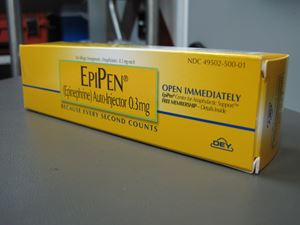
Tens of millions of people have food allergies, and millions more may be unaware that they are allergic to a certain food. As nausea, diarrhea, stomach pain and vomiting are symptoms of both food allergies and food intolerance, minor food allergies are often mistaken for food intolerances such as lactose or gluten intolerance. Food intolerances, however, are very different from food allergies. Food intolerances come on gradually, may not happen every time an effected person eats that food and are not life threatening. Food allergies, on the other hand, set in swiftly, occur every time an effected person eats the food they are allergic to and can be lethal.
Food allergies are caused by an incorrect immune response. The immune system mistakes a specific molecule or protein in certain foods for a dangerous microbe. The body attacks what it sees as an invader often by releasing histamine which causes inflammation. The level of the immune response is what determines the degree to which the allergy affects the person. Someone with a minor peanut allergy might have itchy eyes, diarrhea or a case of hives after accidentally consuming peanuts. A person with a severe allergy could have low blood pressure, difficulty breathing, a swollen tongue or go into anaphylactic shock. People can develop an allergy to any food, but eight allergies are the most common.
Milk
This allergy is most commonly found in children, and most affected children grow out of the allergy as they age. Individuals with a milk allergy need to avoid all milk-based dairy including cheese and butter. For those who are only allergic to cow’s milk, goat cheese or sheep’s milk are possible alternative sources of calcium. Most people who are allergic to milk have a minor allergy and may mistakenly believe themselves to be lactose intolerant.
Eggs
Egg allergies are also most common in children. Like milk allergies, egg allergies are rarely severe, and most children who are affected grow out of the allergy overtime. Unlike most allergies, those who are allergic to eggs do not necessarily have to avoid all products that include eggs. The proteins in eggs change when eggs are cooked, so the body may not react to baked goods that contain cooked eggs.
Peanuts
This is perhaps one of the most well-known allergies and one that is often severe. Peanut allergies affect a large number of people and have been known to cause anaphylactic shock. Individuals who are allergic to peanuts are often allergic to tree nuts as well, but the two allergies do not always go hand in hand.
Tree Nuts
Individuals who are allergic to tree nuts rarely grow out of the allergy. They may only be allergic to one or two tree nuts, or they may be allergic to all tree nuts. Given that a tree nut allergy is often severe, allergic individuals should avoid all tree nuts in order to be safe. Almonds, macadamia nuts, cashew and pine nuts are all examples of tree nuts.
Soy
Like individuals with egg and milk allergies, people who are allergic to soy often outgrow the allergy. Affected individuals need to avoid all soy products, but thankfully the allergy is rarely severe. Strangely enough, some children with a soy allergy also possess a milk allergy, but there has not been a link discovered between the two allergies yet.
Wheat or Gluten
A wheat allergy is not the same as a gluten allergy. Individuals who are allergic to gluten need to avoid wheat, but those who are only allergic to wheat can consume gluten from other sources such as barley or oats. Wheat allergies are not usually severe, but there have been cases of wheat allergies that resulted in anaphylaxis.
Fish
Unlike many allergies, fish allergies can surface later in life. Almost 40 percent of individuals who are allergic to fish developed the allergy during their adult life. Those with fish allergies may only be allergic to one kind of fish, or they may be allergic to all fishes. As this allergy can be severe, it is recommended that people with one known fish allergy avoid all other types of fish to be safe.
Shellfish
Shellfish allergies are not as well-known as tree nut and peanut allergies, but the existence of shellfish allergies does not catch many people off guard. Like individuals with tree nut allergies, people who are allergic to shellfish rarely outgrow the allergy.
The most common protein to trigger an immune response in a shellfish allergy is tropomyosin. Tropomyosin is not the cause of all shellfish allergies, but it does make up the majority of cases. Those individuals with shellfish allergies whose immune systems are not triggered by tropomyosin are usually allergic to either the protein arginine kinase or myosin light chain.
Unlike most allergies, allergic reactions to shellfish are not limited to when an affected individual ingests the food. Shellfish allergies can be triggered by the vapors of cooking shellfish and, given that shellfish allergies are often severe, affected individuals are advised to avoid places where shellfish might be prepared, cooked or served.
Food allergies are reasonably common in the world, with roughly one in 13 people affected. Scientists are researching potential cures for food allergies but have yet to discover a reliable cure. There have been cases of individuals curing allergies by exposing themselves to small amounts of the food they are allergic to, but the results are currently inconclusive. For now, the best action those with food allergies can take is to avoid the food that triggers their allergy. As for individuals who are unsure if they have a food allergy or intolerance, doctor’s offices can test for many allergies but not all. Rather than be tested for allergies, though, it may be best to simply avoid the problematic food. After all, there are plenty of other things to eat.

